Process Development of Fly Ash-Based Geopolymer Mortars in View of the Mechanical Characteristics
Abstract
1. Introduction
2. Experimental and Numerical Analyses
2.1. Materials
2.2. Mix Proportion and Casting
2.3. Testing Procedure
3. Test Results and Discussion
3.1. Workability of Geopolymers
3.2. Bulk Density, Water Absorption, and Porosity
3.3. Compressive and Flexural Strengths
3.4. SEM, EDX, XRD, and TGA-DTA Investigations
4. Conclusions
- This study showed that geopolymer mortars can be manufactured through activation of locally available class F fly ashes (FA and FB) with different alkaline solution types and contents. The acceptable workability was classified as moderate based on the slump flow diameter (15 ± 2 cm), which was obtained for all geopolymer mixtures without adding superplasticizers.
- The chemical compositions of source materials for the geopolymers should be rich in silicon and aluminum oxides. These oxides in class F fly ash react with liquid alkaline to produce geopolymer mortars that bond the fine aggregates or unreacted particles. Considering the test results, the geopolymer mortars designed with FB had gave results than those of FA due to the ratio of silicon oxide (SiO2) to aluminum oxide (Al2O3) by mass of the raw material, which should preferably be in the range of 2.0 to 3.5 to produce geopolymers with better strength characteristics.
- The highest bulk density was 1985 kg/m3 for 40B-3-70, whereas 40A-3-100 gave the lowest value (1355 kg/m3). Considering FA and FB, the fineness or particle size distribution of F was one of the main parameters in terms of the physical characteristics of the geopolymer mortars, as well as the Na2SiO3/NaOH and L/S ratios. The bulk density was increased by the ratios of L/S and Na2SiO3/NaOH at low curing temperatures due to the geopolymerization reaction not being fully completed at such curing temperatures for the hardened mortars. However, curing at high temperature (100 °C) resulted in a reduction in the bulk density due to the expansion and tough structure of the geopolymer samples.
- The water absorption and porosity values changed between 10.07% and 17.98% and between 16.71% and 27.77%, respectively. Hardened geopolymer mortars produced with an L/S ratio of 0.4 resulted in higher values of water absorption and apparent porosity when compared to the ones produced with a lower L/S ratio based on the increases in the alkaline solution and water. However, regardless of the L/S ratio, the apparent porosity and the water absorption increased with the increasing ratio of Na2SiO3/NaOH for the samples cured at 100 °C due to the geopolymerization.
- The highest compressive and flexural strength values were found to be 60.1 MPa and 9.9 MPa for the mixture with the L/S ratio of 0.2 cured at 100 °C for 28 days. It can be concluded that using excessive activator solutions caused less alkali reaction, which weakened the bonding in the geopolymer matrix. On the other hand, the decrease in mechanical properties of geopolymers after using the optimal Na2SiO3/NaOH ratio was attributed to an increase in the coagulation of the silica.
- The heat curing process substantially affected the chemical reaction that occurs in the geopolymer mortar based on the type of fly ash. Higher curing temperatures resulted in better compressive strength for both fly ashes due to the improvement of kinetic energy, as well as the reaction degree, which caused the geopolymer mortars to have a stronger Al-Si-O network.
- Considering all of the test results, in order to obtain the best strength characteristics, the curing temperature, L/S ratio, and Na2SiO3/NaOH should be 100 °C, 0.2, and 2.5, respectively, for FA, whereas a curing temperature of 100 °C, L/S ratio of 0.2, and Na2SiO3/NaOH ratio of 2 were optimal for FB.
- SEM analysis indicated that the compact composite matrix was enhanced for 20FB-2-100, which had the highest compressive strength among the tested samples. The EDX analysis showed that FB with more soluble silica, increased temperature, and an increased Na2SiO3/NaOH ratio improved the mechanical performance by providing a better geopolymerization reaction. According to the XRD analysis, SiO2 and Al2O3 in F for the 20FA-1-70 mixture did not fully take part in the geopolymerization, which resulted in lower compressive strength. In addition, DTA peaks observed in the range of 30–165 °C supported the mechanical tests by showing that the N-A-S-H peak increased with the increased compressive strength.
- The production of fly-ash-based geopolymers not only provides an opportunity to use F as a sustainable green material via alkaline activation but also avoids the disposal problems associated with F. Additionally, this method contributes to the environment by decreasing CO2 emissions into the atmosphere, since it is a cement-free technology. Thus, geopolymers manufactured in this study with the desired strength characteristics can be used as brick building blocks, tiles, and prefabricated materials, as well as in infrastructure works.
Author Contributions
Funding
Institutional Review Board Statement
Informed Consent Statement
Data Availability Statement
Acknowledgments
Conflicts of Interest
References
- Bhutta, A.; Farooq, M.; Zanotti, C.; Banthia, N. Pull-out behavior of different fibers in geopolymer mortars: Effects of alkaline solution concentration and curing. Mater. Struct. 2016, 50, 80. [Google Scholar] [CrossRef]
- Hardjito, D.; Wallah, S.E.; Sumajouw, D.M.J.; Rangan, B.V. On the development of fly ash-based geopolymer concrete. ACI Mater. J. 2004, 101, 467–472. [Google Scholar]
- Chithambaram, S.J.; Kumar, S.; Prasad, M.M.; Adak, D. Effect of parameters on the compressive strength of fly ash based geopolymer concrete. Struct. Concr. 2018, 19, 1202–1209. [Google Scholar] [CrossRef]
- Nguyen, K.; Le, T.A.; Lee, J.; Lee, D.; Lee, K. Investigation on properties of geopolymer mortar using preheated materials and thermogenetic admixtures. Constr. Build. Mater. 2017, 130, 146–155. [Google Scholar] [CrossRef]
- Zhang, P.; Zheng, Y.; Wang, K.; Zhang, J. A review on properties of fresh and hardened geopolymer mortar. Compos. Part B Eng. 2018, 152, 79–95. [Google Scholar] [CrossRef]
- Khale, D.; Chaudhary, R. Mechanism of geopolymerization and factors influencing its development: A review. J. Mater. Sci. 2007, 42, 729–746. [Google Scholar] [CrossRef]
- Islam, A.; Alengaram, U.J.; Jumaat, M.Z.; Bashar, I.I. The development of compressive strength of ground granulated blast furnace slag-palm oil fuel ash-fly ash based geopolymer mortar. Mater. Des. 2014, 56, 833–841. [Google Scholar] [CrossRef]
- Davidovits, J. Geopolymer Chemistry and Applications; Insitut Geopolymere: Saint-Quentin, France, 2011. [Google Scholar]
- Jumrat, S.; Chatveera, B.; Rattanadecho, P. Dielectric properties and temperature profile of fly ash-based geopolymer mortar. Int. Commun. Heat Mass Transf. 2011, 38, 242–248. [Google Scholar] [CrossRef]
- Adam, A.A.; Horianto, X. The Effect of Temperature and Duration of Curing on the Strength of Fly Ash Based Geopolymer Mortar. Procedia Eng. 2014, 95, 410–414. [Google Scholar] [CrossRef]
- Görhan, G.; Kürklü, G. The influence of the NaOH solution on the properties of the fly ash-based geopolymer mortar cured at different temperatures. Compos. Part B Eng. 2014, 58, 371–377. [Google Scholar] [CrossRef]
- Álvarez-Ayuso, E.; Querol, X.; Plana, F.; Alastuey, A.; Moreno, N.; Izquierdo, M.; Font, O.; Moreno, T.; Díez, S.; Vázquez, E.; et al. Environmental, physical and structural characterisation of geopolymer matrixes synthesised from coal (co-)combustion fly ashes. J. Hazard. Mater. 2008, 154, 175–183. [Google Scholar] [CrossRef]
- Komnitsas, K.A. Potential of geopolymer technology towards green buildings and sustainable cities. Procedia Eng. 2011, 21, 1023–1032. [Google Scholar] [CrossRef]
- McLellan, B.C.; Williams, R.P.; Lay, J.; van Riessen, A.; Corder, G. Costs and carbon emissions for geopolymer pastes in comparison to ordinary portland cement. J. Clean. Prod. 2011, 19, 1080–1090. [Google Scholar] [CrossRef]
- Ng, C.; Alengaram, U.J.; Wong, L.S.; Mo, K.H.; Jumaat, M.Z.; Ramesh, S. A review on microstructural study and compressive strength of geopolymer mortar, paste and concrete. Constr. Build. Mater. 2018, 186, 550–576. [Google Scholar] [CrossRef]
- Dimas, D.; Giannopoulou, I.; Panias, D. Polymerization in sodium silicate solutions: A fundamental process in geopolymerization technology. J. Mater. Sci. 2009, 44, 3719–3730. [Google Scholar] [CrossRef]
- Abdel-Gawwad, H.; Abo-El-Enein, S. A novel method to produce dry geopolymer cement powder. HBRC J. 2016, 12, 13–24. [Google Scholar] [CrossRef]
- Sumesh, M.; Alengaram, U.J.; Jumaat, M.Z.; Mo, K.H.; Alnahhal, M.F. Incorporation of nano-materials in cement composite and geopolymer based paste and mortar—A review. Constr. Build. Mater. 2017, 148, 62–84. [Google Scholar] [CrossRef]
- Comrie, D.C.; Kriven, W.M. Composite Cold Ceramic Geopolymer in a Refractory Application. In Proceedings of the Advances in Ceramic Matrix Composites IX, Nashville, TN, USA, 27–30 April 2012; pp. 211–225. [Google Scholar]
- Schmücker, M.; MacKenzie, K.J. Microstructure of sodium polysialate siloxo geopolymer. Ceram. Int. 2005, 31, 433–437. [Google Scholar] [CrossRef]
- Van Jaarsveld, J.; Van Deventer, J.; Schwartzman, A. The potential use of geopolymeric materials to immobilise toxic metals: Part II. Material and leaching characteristics. Miner. Eng. 1999, 12, 75–91. [Google Scholar] [CrossRef]
- de Vargas, A.S.; Molin, D.C.D.; Vilela, A.C.; da Silva, F.J.; Pavão, B.; Veit, H. The effects of Na2O/SiO2molar ratio, curing temperature and age on compressive strength, morphology and microstructure of alkali-activated fly ash-based geopolymers. Cem. Concr. Compos. 2011, 33, 653–660. [Google Scholar] [CrossRef]
- Hu, M.; Zhu, X.; Long, F. Alkali-activated fly ash-based geopolymers with zeolite or bentonite as additives. Cem. Concr. Compos. 2009, 31, 762–768. [Google Scholar] [CrossRef]
- Bakharev, T. Geopolymeric materials prepared using Class F fly ash and elevated temperature curing. Cem. Concr. Res. 2005, 35, 1224–1232. [Google Scholar] [CrossRef]
- Kumar, V.V.P.; Prasad, N.; Dey, S. Influence of metakaolin on strength and durability characteristics of ground granulated blast furnace slag based geopolymer concrete. Struct. Concr. 2019, 21, 1040–1050. [Google Scholar] [CrossRef]
- Criado, M.; Palomo, A.; Fernandezjimenez, A. Alkali activation of fly ashes. Part 1: Effect of curing conditions on the carbonation of the reaction products. Fuel 2005, 84, 2048–2054. [Google Scholar] [CrossRef]
- Fernández-Jiménez, A.; Palomo, A. Composition and microstructure of alkali activated fly ash binder: Effect of the activator. Cem. Concr. Res. 2005, 35, 1984–1992. [Google Scholar] [CrossRef]
- Fernández-Jiménez, A.; Palomo, A. Characterisation of fly ashes. Potential reactivity as alkaline cements. Fuel 2003, 82, 2259–2265. [Google Scholar] [CrossRef]
- Pinto, A.T. Alkali-Activated Metakaolin Based Binders. Ph.D. Thesis, University of Minho, Braga, Portugal, 2004. [Google Scholar]
- Hardjito, D.; Wallah, S.E.; Sumajouw, D.M.J.; Rangan, B.V. Properties of geopolymer concrete with fly ash as source material: Effect of mixture composition. Spec. Publ. 2004, 222, 109–118. [Google Scholar]
- Bhowmick, A.; Ghosh, S. Effect of synthesizing parameters on workability and compressive strength of fly ash based geopolymer mortar. Int. J. Civ. Struct. Eng. 2012, 3, 168–177. [Google Scholar]
- Wazien, A.W.; Abdullah, M.M.A.B.; Razak, R.A.; Rozainy, M.M.R.; Tahir, M.F.M. Strength and Density of Geopolymer Mortar Cured at Ambient Temperature for Use as Repair Material. IOP Conf. Ser. Mater. Sci. Eng. 2016, 133, 012042. [Google Scholar] [CrossRef]
- Mo, B.-H.; Zhu, H.; Cui, X.-M.; He, Y.; Gong, S.-Y. Effect of curing temperature on geopolymerization of metakaolin-based geopolymers. Appl. Clay Sci. 2014, 99, 144–148. [Google Scholar] [CrossRef]
- Al Bakria, A.M.; Kamarudin, H.; Binhussain, M.; Nizar, I.; Zarina, Y.; Rafiza, A. The Effect of Curing Temperature on Physical and Chemical Properties of Geopolymers. Phys. Procedia 2011, 22, 286–291. [Google Scholar] [CrossRef]
- Atiş, C.D.; Görür, E.B.; Karahan, O.; Bilim, C.; İlkentapar, S.; Luga, E. Very high strength (120 MPa) class F fly ash geopolymer mortar activated at different NaOH amount, heat curing temperature and heat curing duration. Constr. Build. Mater. 2015, 96, 673–678. [Google Scholar] [CrossRef]
- Thokchom, S.; Ghosh, P.; Ghosh, S. Effect of water absorption, porosity and sorptivity on durability of geopolymer mortars. ARPN J. Eng. Appl. Sci. 2009, 4, 28–32. [Google Scholar]
- Patankar, S.V.; Ghugal, Y.M.; Jamkar, S.S. Effect of Concentration of Sodium Hydroxide and Degree of Heat Curing on Fly Ash-Based Geopolymer Mortar. Indian J. Mater. Sci. 2014, 2014, 1–6. [Google Scholar] [CrossRef]
- Joseph, B.; Mathew, G. Influence of aggregate content on the behavior of fly ash based geopolymer concrete. Sci. Iran. 2012, 19, 1188–1194. [Google Scholar] [CrossRef]
- ASTM C618. Standard Specification for Coal Fly Ash and Raw or Calcined Natural Pozzolan for Use as a Mineral Admixture in Portland Cement Concrete; ASTM International: West Conshohocken, PA, USA, 2002; pp. 1–10. [Google Scholar]
- ASTM C1437. Standard Test Method for Flow of Hydraulic Cement Mortar; ASTM International: West Conshohocken, PA, USA, 2007. [Google Scholar]
- ASTM C642-13. Standard Test Method for Density, Absorption, and Voids in Hardened Concrete; ASTM International: West Conshohocken, PA, USA, 2013. [Google Scholar]
- ASTM C349. Standard Test Method for Compressive Strength of Hydraulic-Cement Mortars (Using Portions of Prisms Broken in Flexure); ASTM International: West Conshohocken, PA, USA, 2008. [Google Scholar]
- ASTM C348. Standard Test Method for Flexural Strength of Hydraulic-Cement Mortars; ASTM International: West Conshohocken, PA, USA, 2008. [Google Scholar]
- Chindaprasirt, P.; Chareerat, T.; Sirivivatnanon, V. Workability and strength of coarse high calcium fly ash geopolymer. Cem. Concr. Compos. 2007, 29, 224–229. [Google Scholar] [CrossRef]
- Mermerdaş, K.; Manguri, S.; Nassani, D.E.; Oleiwi, S.M. Effect of aggregate properties on the mechanical and absorption characteristics of geopolymer mortar. Eng. Sci. Technol. Int. J. 2017, 20, 1642–1652. [Google Scholar] [CrossRef]
- SteinerOva, M. Mechanical properties of geopolymer mortars in relation to their porous structure. Ceram. Silikáty 2011, 55, 362–372. [Google Scholar]
- AACI Standard. Building Code Requirements for Structural Concrete (ACI 318-11); American Concrete Institute: Farmington Hill, MI, USA, 2011. [Google Scholar]
- Komljenović, M.; Baščarević, Z.; Bradić, V. Mechanical and microstructural properties of alkali-activated fly ash geopolymers. J. Hazard. Mater. 2011, 181, 35–42. [Google Scholar] [CrossRef] [PubMed]
- Kong, D.L.; Sanjayan, J.G. Effect of elevated temperatures on geopolymer paste, mortar and concrete. Cem. Concr. Res. 2010, 40, 334–339. [Google Scholar] [CrossRef]
- Petermann, J.C.; Saeed, A.; Hammons, M.I. Alkali-Activated Geopolymers: A Literature Review. Mater. Sci. 2010, 4–6. [Google Scholar] [CrossRef]
- Zuda, L.; Pavlík, Z.; Rovnaníková, P.; Bayer, P.; Černý, R. Properties of alkali activated aluminosilicate material after thermal load. Int. J. Thermophys. 2006, 27, 1250–1263. [Google Scholar] [CrossRef]
- Mustafa Al Bakri, A.M.; Kamarudin, H.; Bnhussain, M.; Rafiza, A.R.; Zarina, Y. Effect of Na2SiO3/NaOH Ratios and NaOH Molarities on Compressive Strength of Fly-Ash-Based Geopolymer. ACI Mater. J. 2012, 109, 503–508. [Google Scholar]
- Xu, H.; Van Deventer, J.S.J. The geopolymerisation of alumino-silicate minerals. Int. J. Miner. Process. 2000, 59, 247–266. [Google Scholar] [CrossRef]
- Barbosa, V.F.; MacKenzie, K.J.; Thaumaturgo, C. Synthesis and characterisation of materials based on inorganic polymers of alumina and silica: Sodium polysialate polymers. Int. J. Inorg. Mater. 2000, 2, 309–317. [Google Scholar] [CrossRef]
- Yang, T.-R.; Chang, T.-P.; Chen, B.-T.; Shih, J.-Y.; Lin, W.-L. Effect of alkaline solutions on engineering properties of alkali-activated GGBFS paste. J. Mar. Sci. Technol. 2012, 20, 311–318. [Google Scholar]
- Hardjito, D.; Wallah, S.; Sumajouw, D.M.J.; Rangan, B.V. Fly Ash-Based Geopolymer Concrete. Aust. J. Struct. Eng. 2005, 6, 77–86. [Google Scholar] [CrossRef]
- Yan, D.; Chen, S.; Zeng, Q.; Xu, S.; Li, H. Correlating the elastic properties of metakaolin-based geopolymer with its composition. Mater. Des. 2016, 95, 306–318. [Google Scholar] [CrossRef]
- Glid, M.; Sobrados, I.; Ben Rhaiem, H.; Sanz, J.; Amara, A.B.H. Alkaline activation of metakaolinite-silica mixtures: Role of dissolved silica concentration on the formation of geopolymers. Ceram. Int. 2017, 43, 12641–12650. [Google Scholar] [CrossRef]
- Rattanasak, U.; Chindaprasirt, P. Influence of NaOH solution on the synthesis of fly ash geopolymer. Miner. Eng. 2009, 22, 1073–1078. [Google Scholar] [CrossRef]
- De Silva, P.; Sagoe-Crenstil, K. Medium-term phase stability of Na2O–Al2O3–SiO2–H2O geopolymer systems. Cem. Concr. Res. 2008, 38, 870–876. [Google Scholar] [CrossRef]
- Afridi, S.; Sikandar, M.A.; Waseem, M.; Nasir, H.; Naseer, A. Chemical durability of superabsorbent polymer (SAP) based geopolymer mortars (GPMs). Constr. Build. Mater. 2019, 217, 530–542. [Google Scholar] [CrossRef]
- De Silva, P.; Sagoe-Crenstil, K.; Sirivivatnanon, V. Kinetics of geopolymerization: Role of Al2O3 and SiO2. Cem. Concr. Res. 2007, 37, 512–518. [Google Scholar] [CrossRef]
- Abdulkareem, O.A.; Al Bakri, A.M.; Kamarudin, H.; Nizar, I.K.; Saif, A.A. Effects of elevated temperatures on the thermal behavior and mechanical performance of fly ash geopolymer paste, mortar and lightweight concrete. Constr. Build. Mater. 2014, 50, 377–387. [Google Scholar] [CrossRef]
- Kovářík, T.; Rieger, D.; Kadlec, J.; Křenek, T.; Kullová, L.; Pola, M.; Bělský, P.; Franče, P.; Říha, J. Thermomechanical properties of particle-reinforced geopolymer composite with various aggregate gradation of fine ceramic filler. Constr. Build. Mater. 2017, 143, 599–606. [Google Scholar] [CrossRef]
- Duan, P.; Yan, C.; Zhou, W.; Luo, W. Fresh properties, mechanical strength and microstructure of fly ash geopolymer paste reinforced with sawdust. Constr. Build. Mater. 2016, 111, 600–610. [Google Scholar] [CrossRef]
- He, P.; Jia, D.; Wang, M.; Zhou, Y. Thermal evolution and crystallization kinetics of potassium-based geopolymer. Ceram. Int. 2011, 37, 59–63. [Google Scholar] [CrossRef]
- Kim, G.M.; Jang, J.G.; Naeem, F.; Lee, H.K. Heavy Metal Leaching, CO2 Uptake and Mechanical Characteristics of Carbonated Porous Concrete with Alkali-Activated Slag and Bottom Ash. Int. J. Concr. Struct. Mater. 2015, 9, 283–294. [Google Scholar] [CrossRef]
- Sivasakthi, M.; Jeyalakshmi, R.; Rajamane, N.P.; Jose, R. Thermal and structural micro analysis of micro silica blended fly ash based geopolymer composites. J. Non Cryst. Solids 2018, 499, 117–130. [Google Scholar]

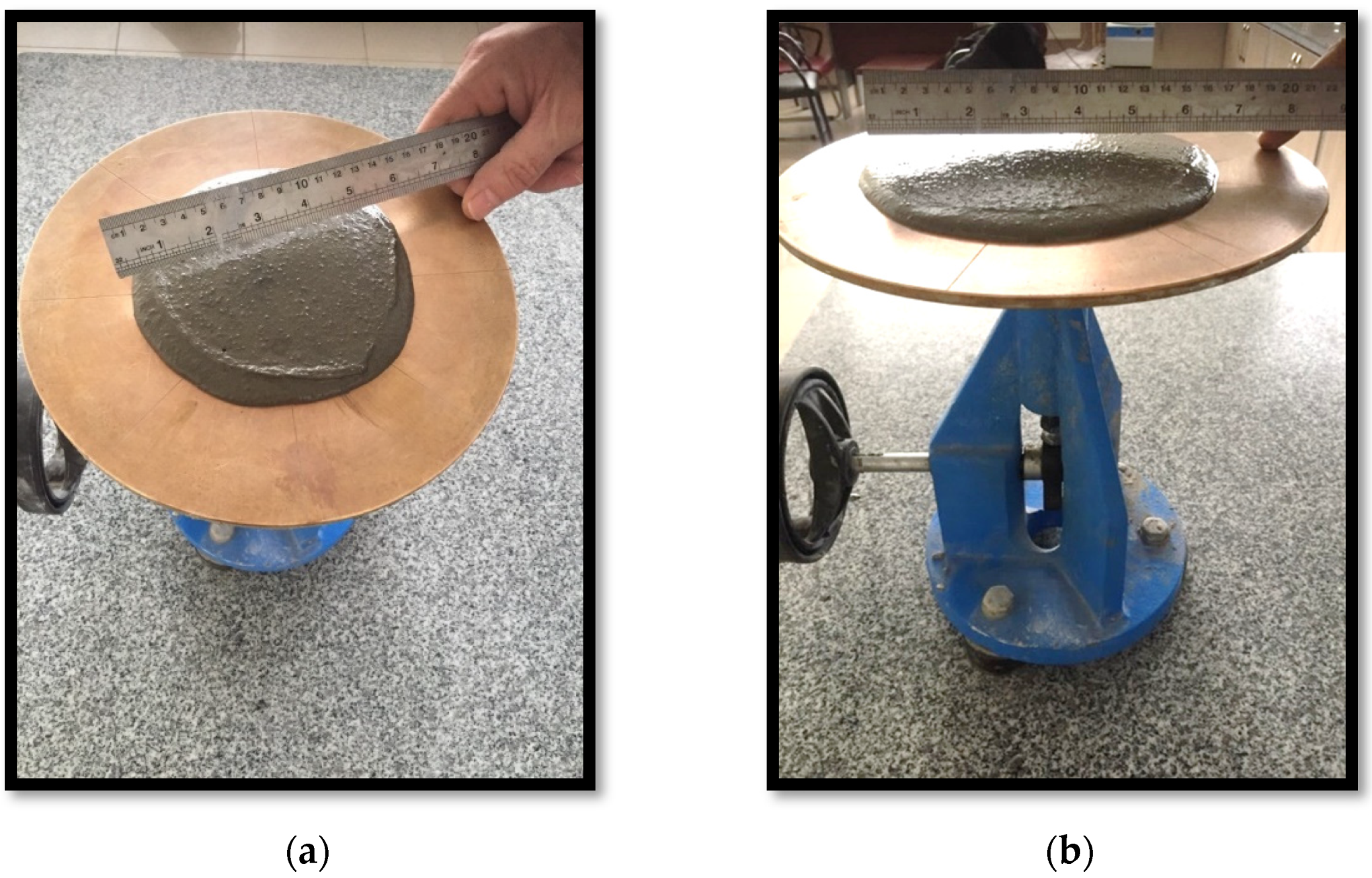

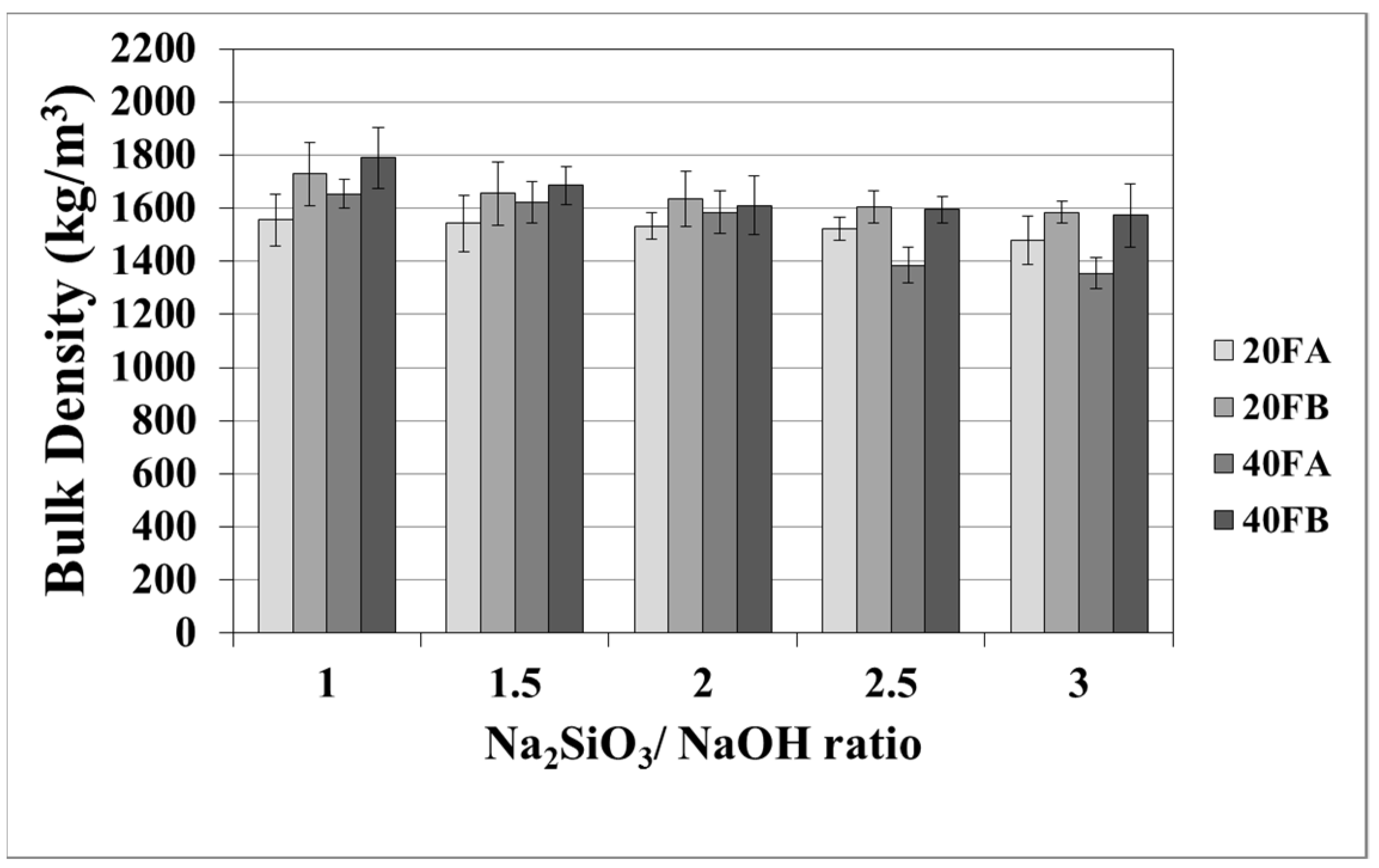
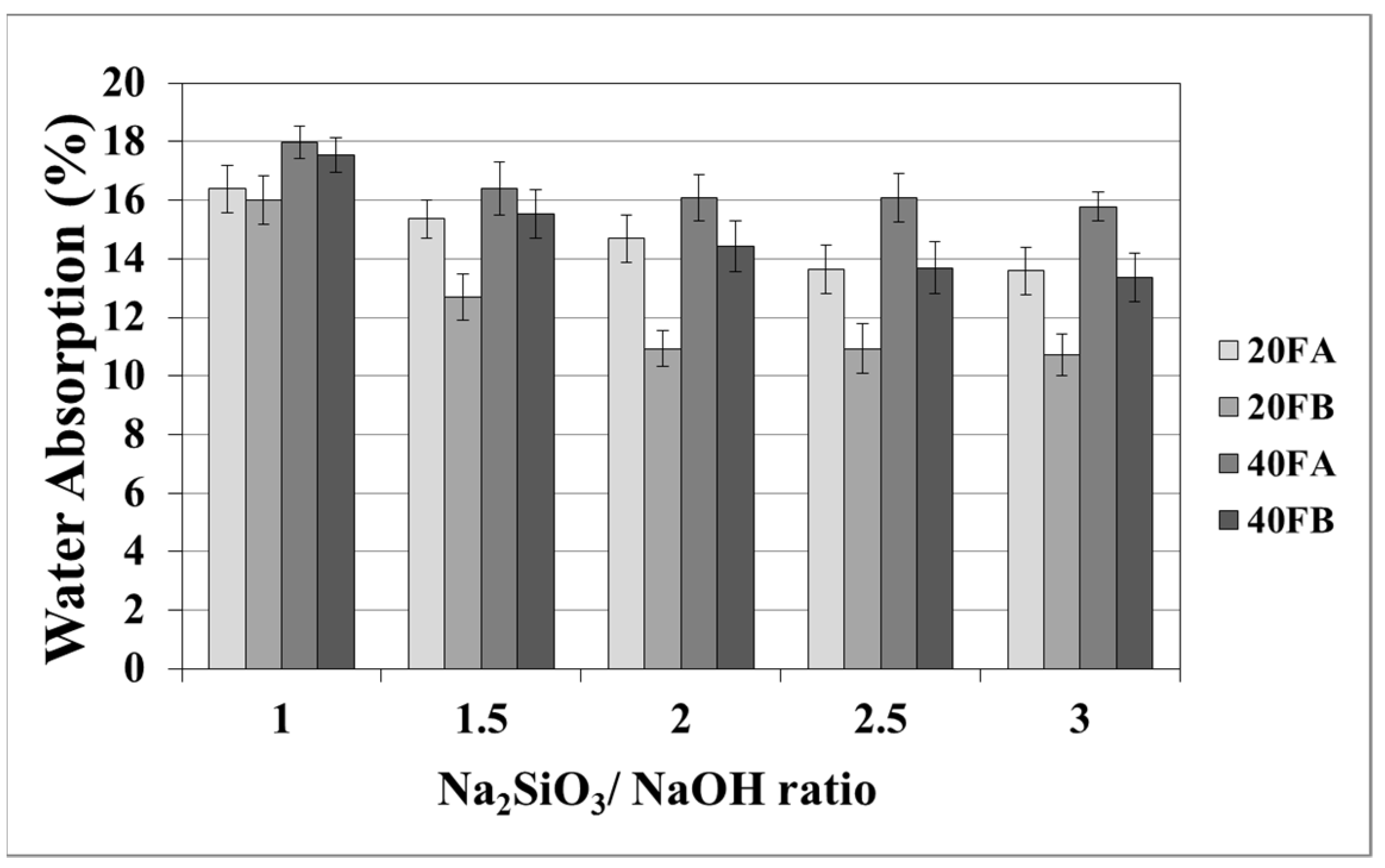
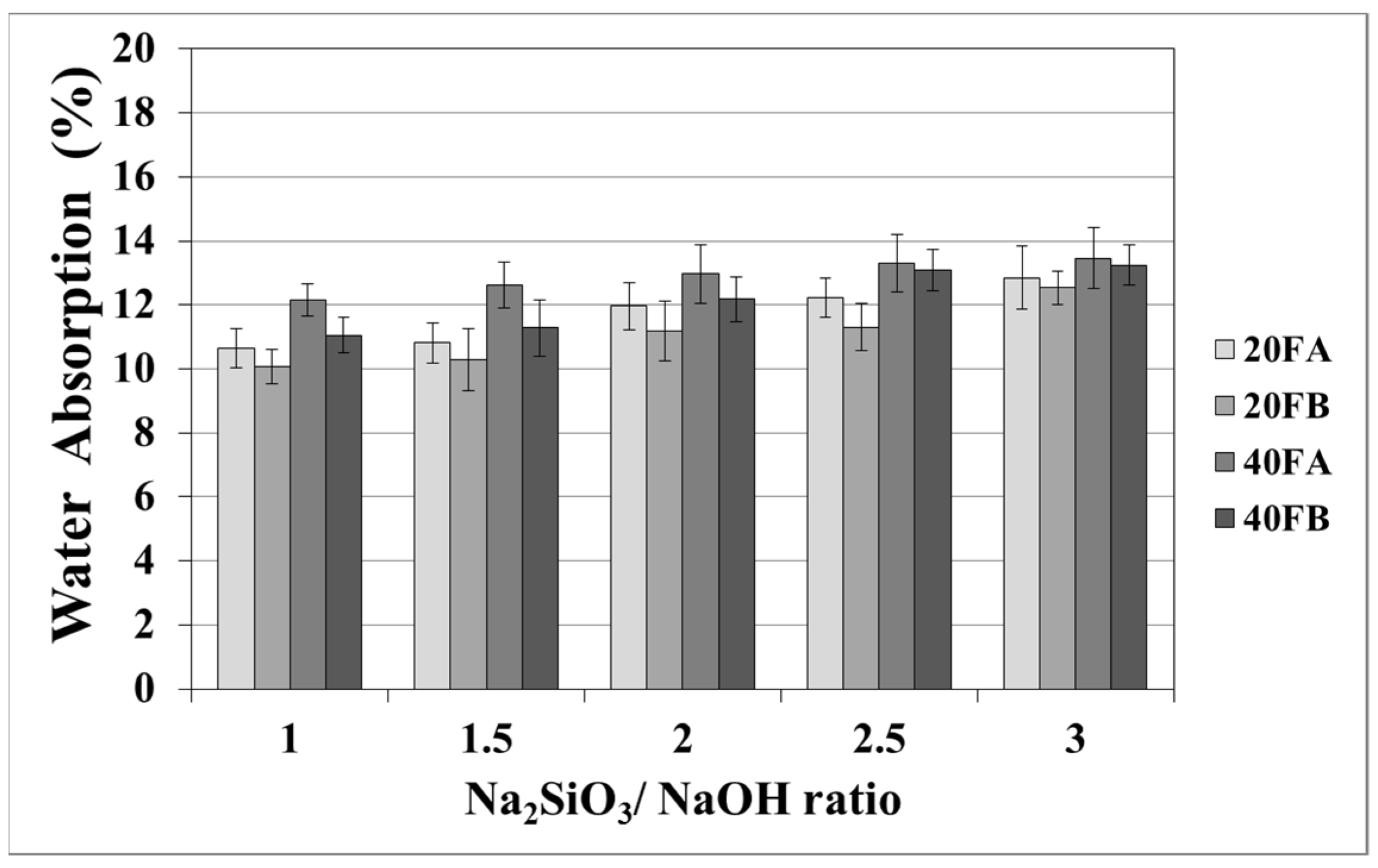
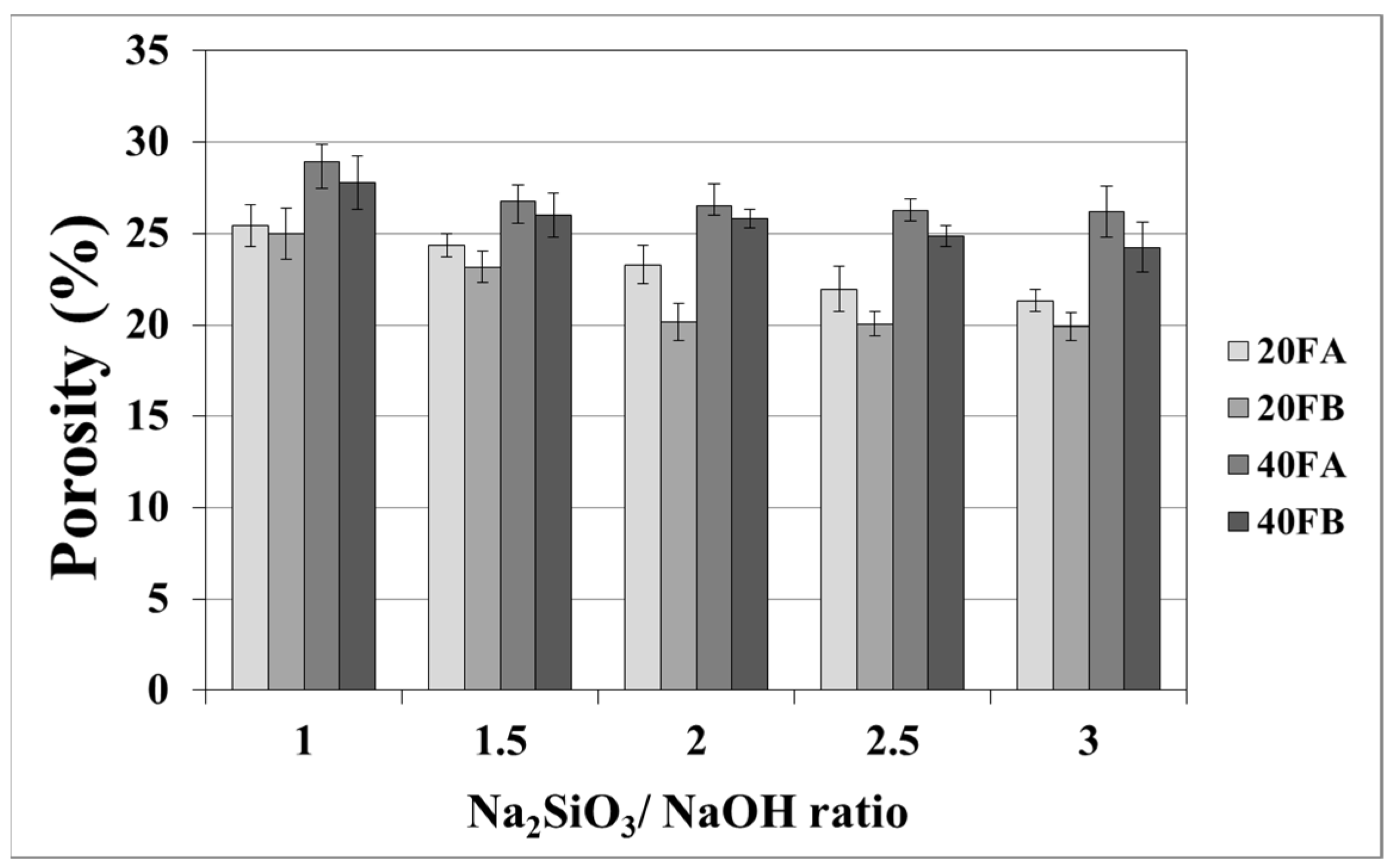
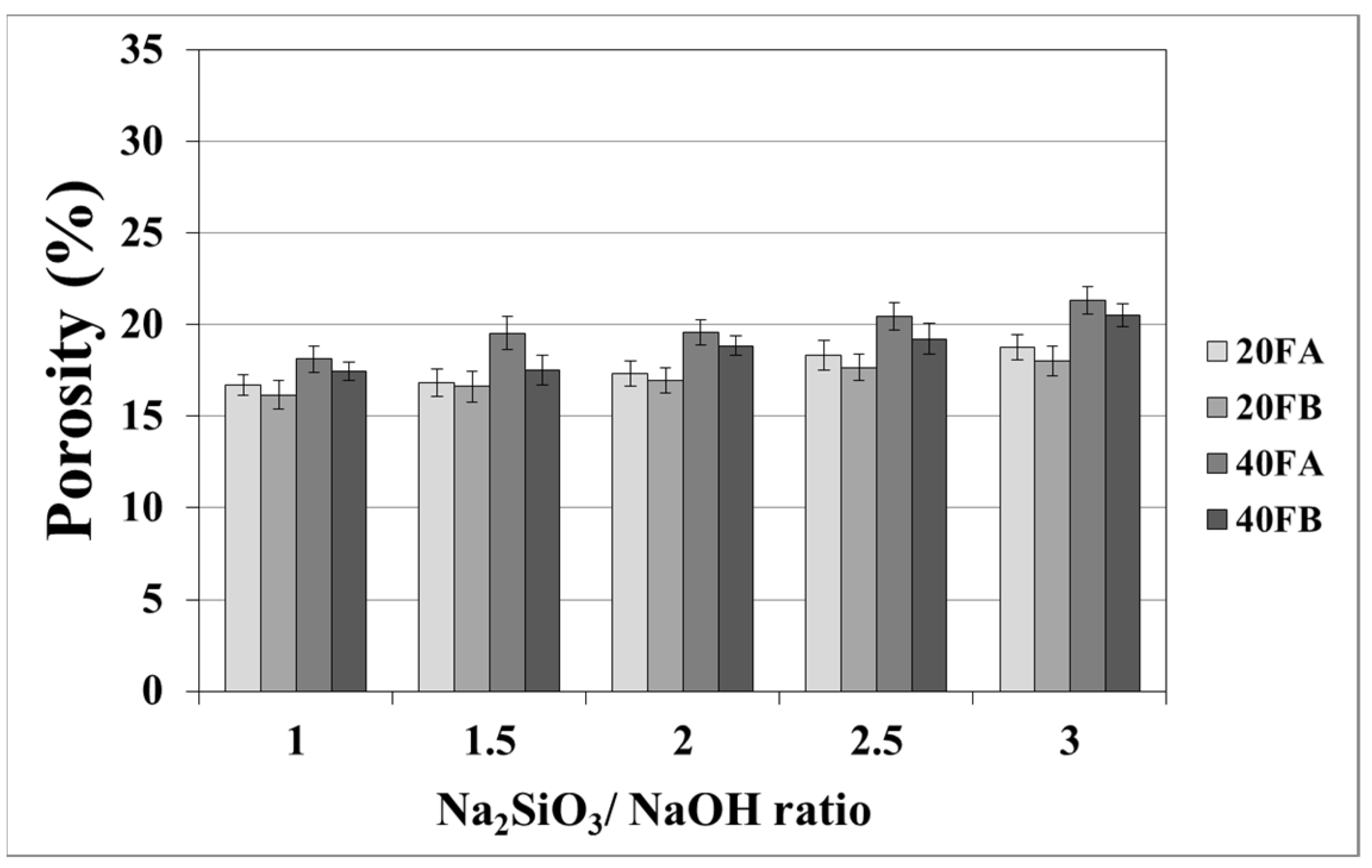
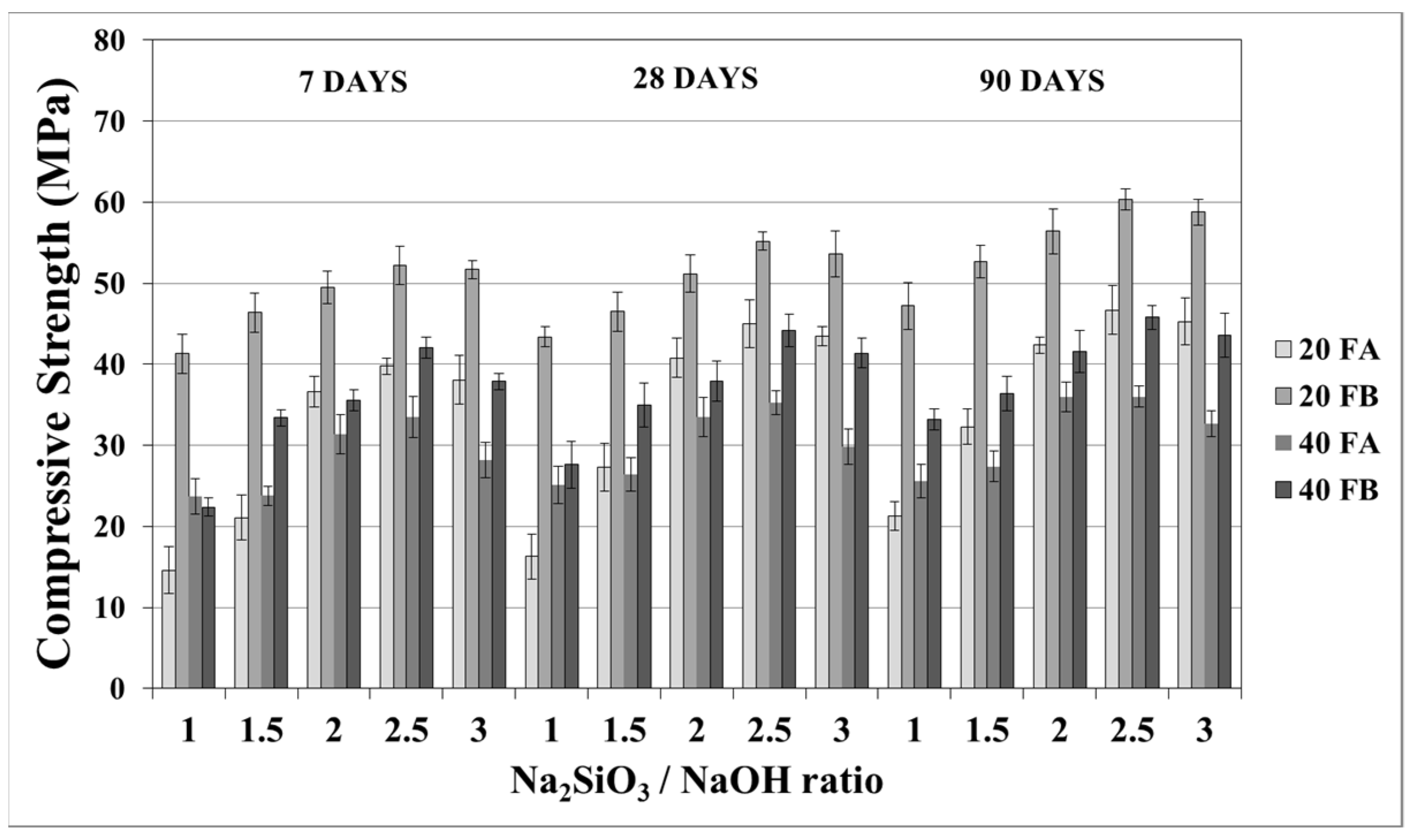
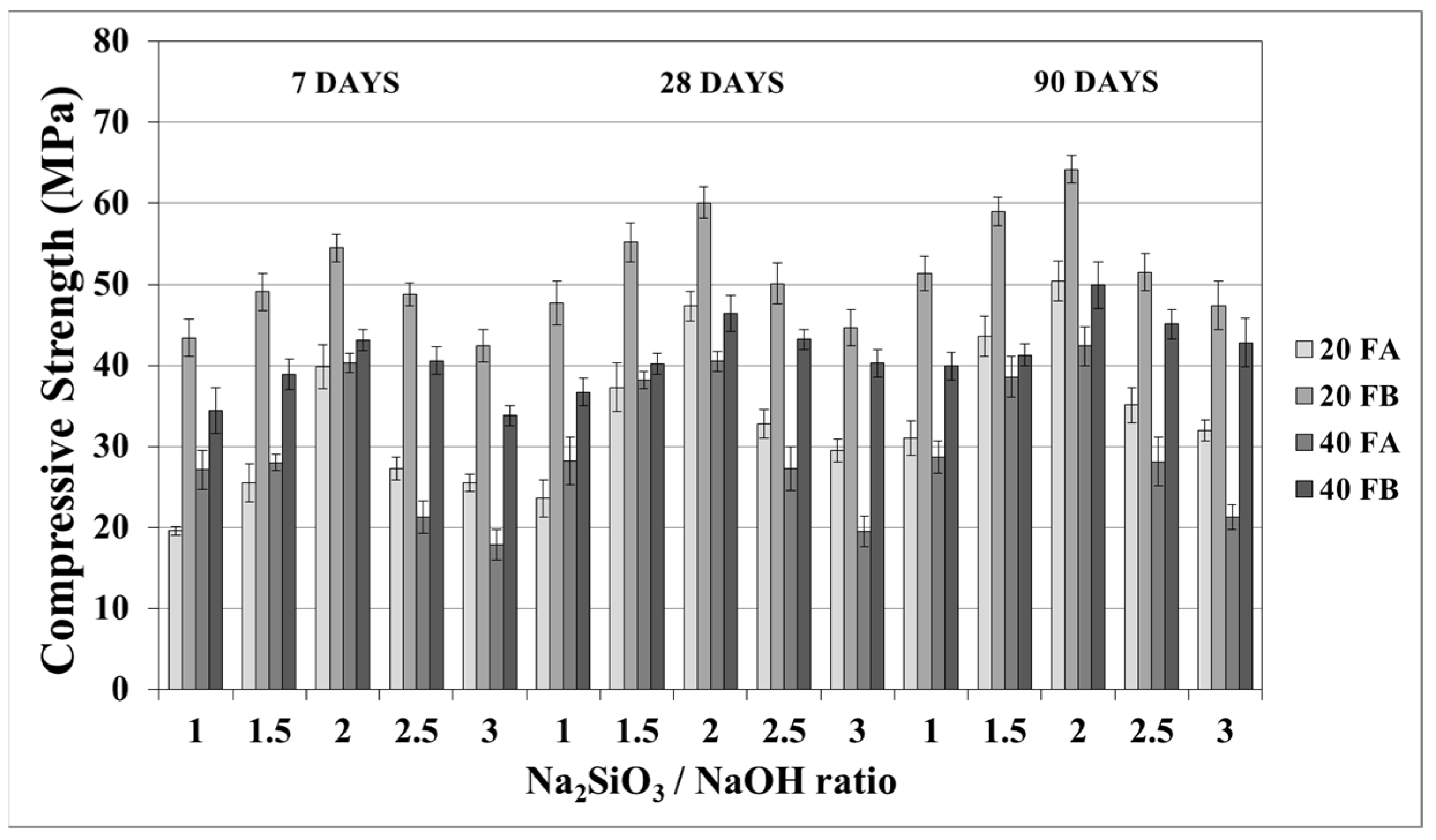
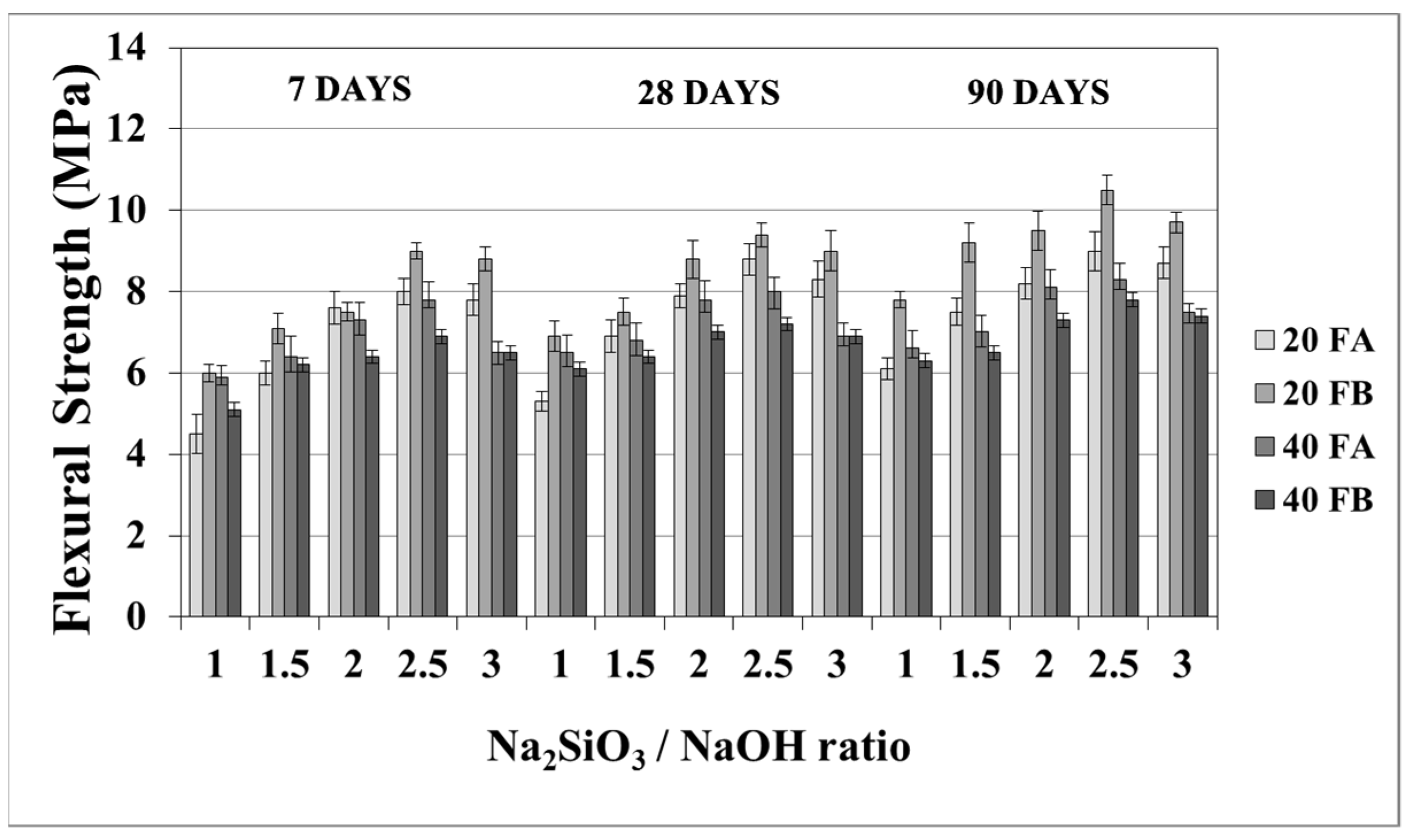

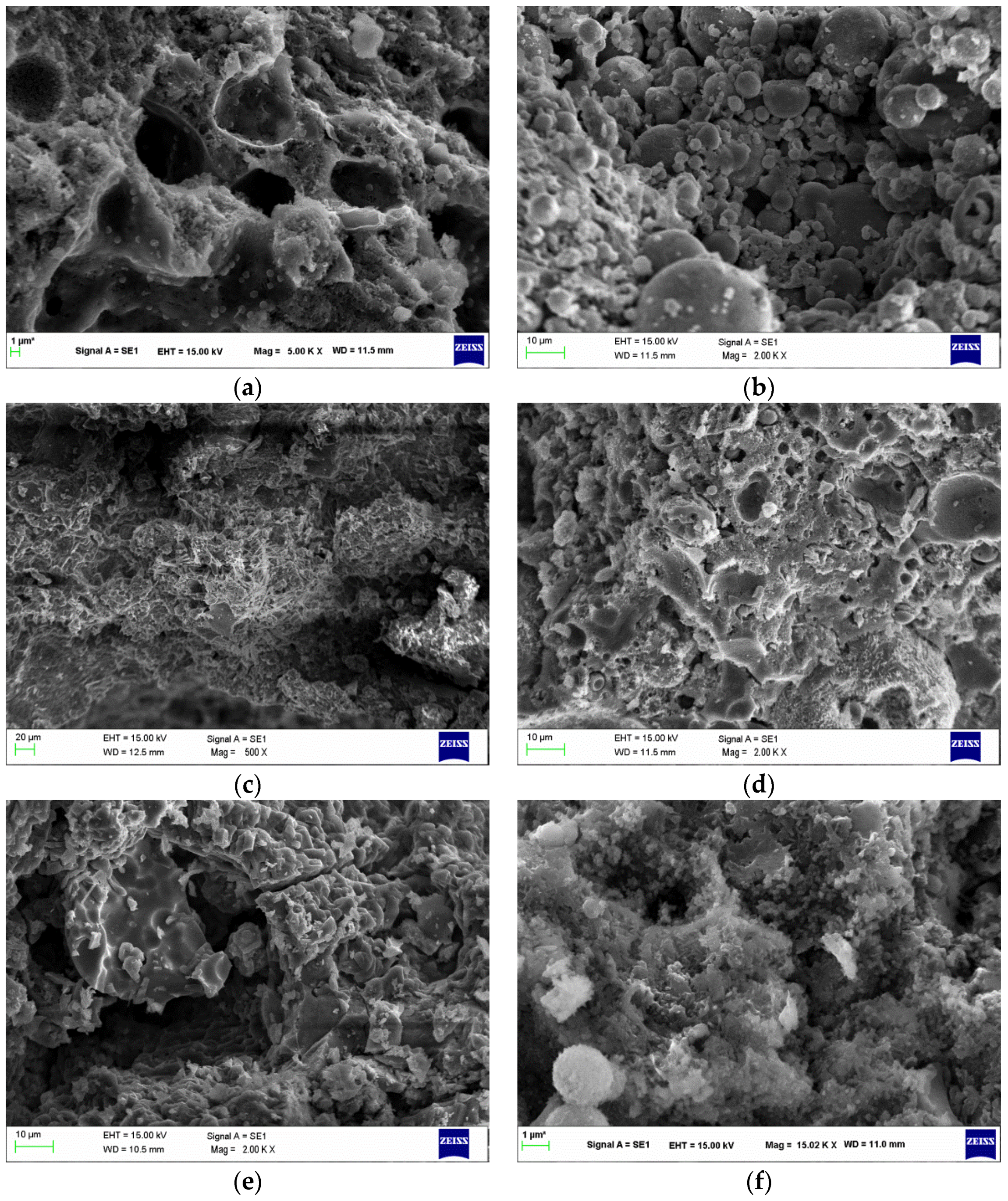
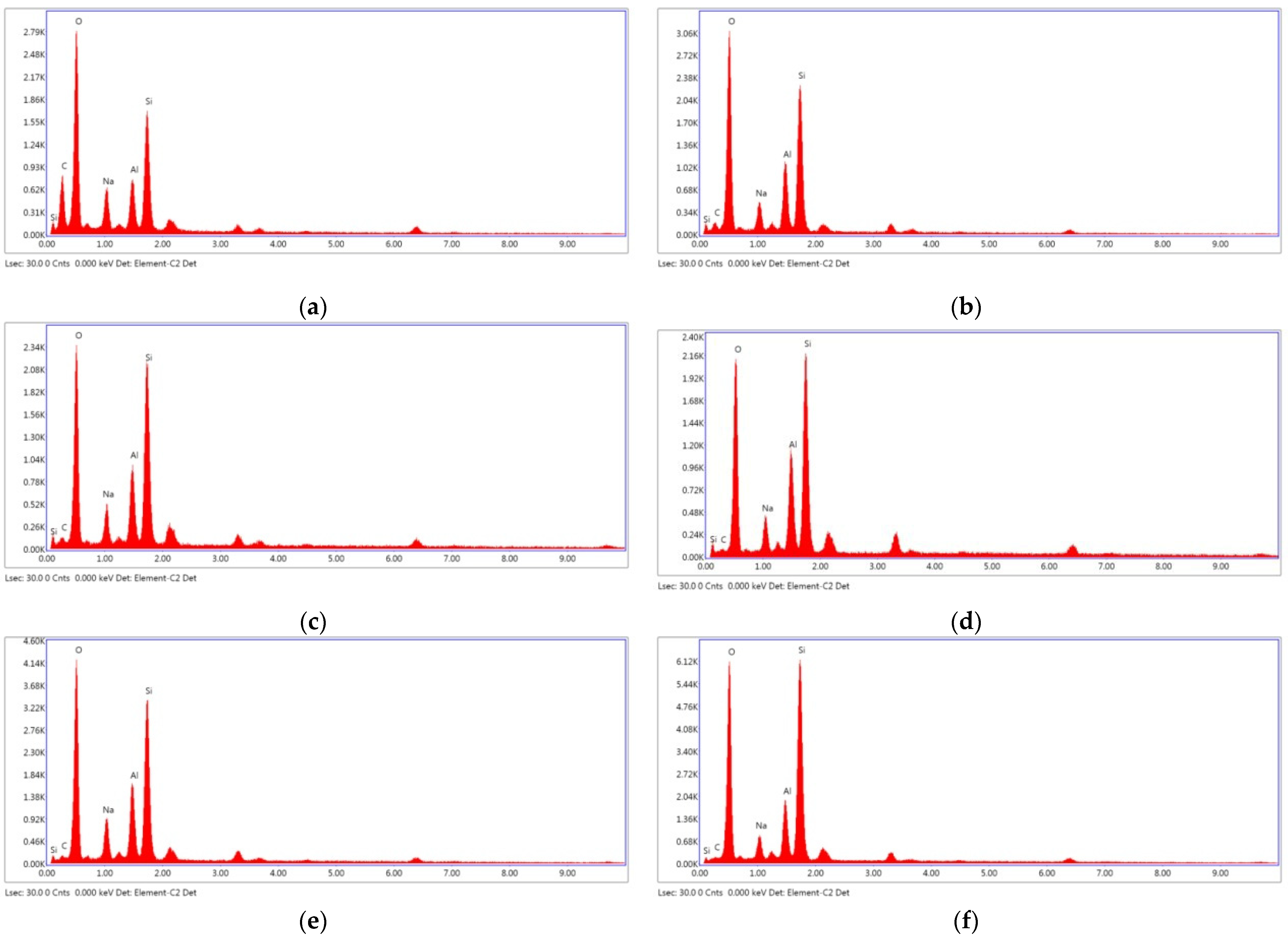
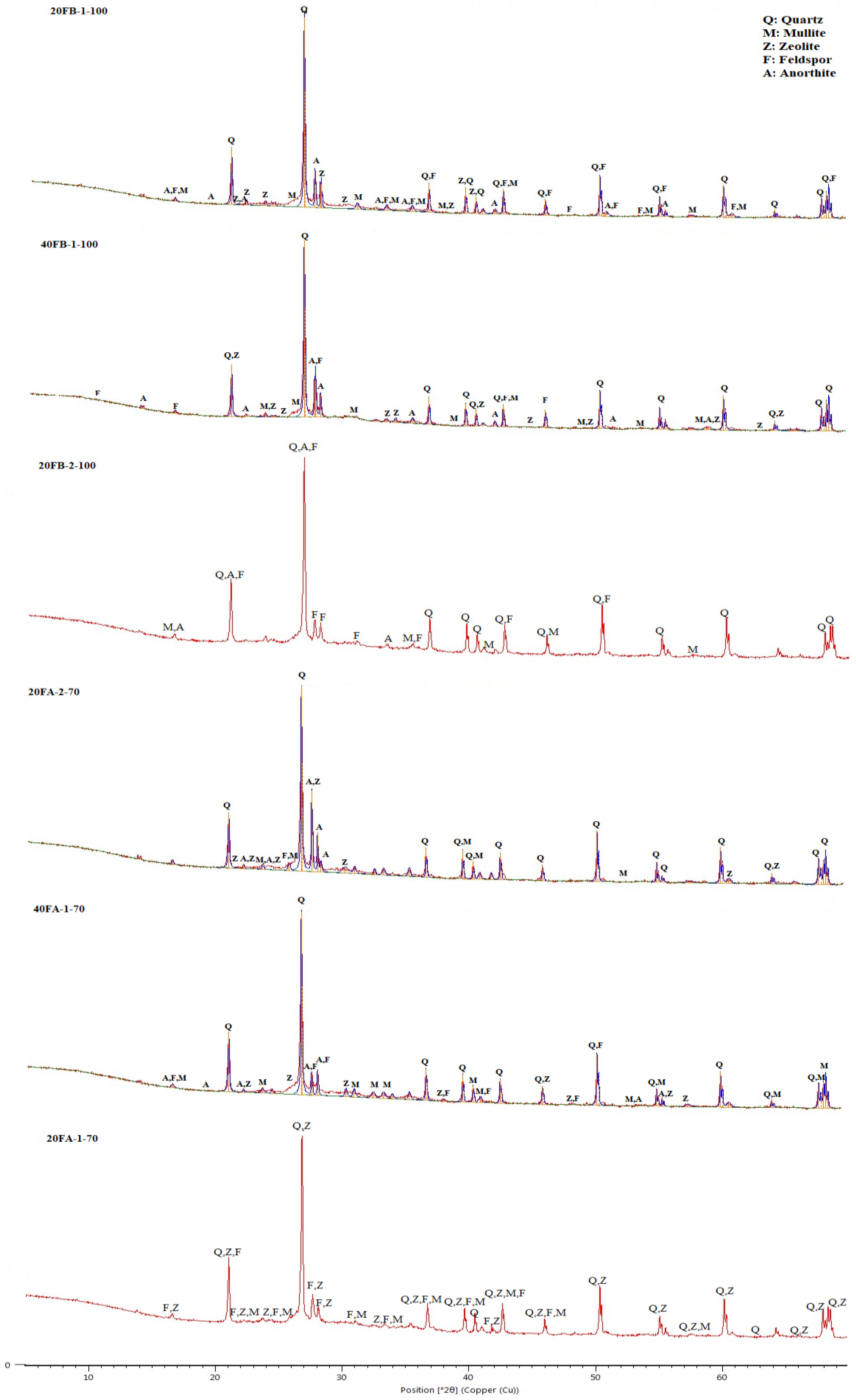

| Analysis Report (%) | FA | FB |
|---|---|---|
| CaO | 2.00 | 1.53 |
| SiO2 | 54.08 | 62.28 |
| Al2O3 | 26.08 | 21.46 |
| Fe2O3 | 6.68 | 7.01 |
| MgO | 2.67 | 2.37 |
| SO3 | 0.73 | 0.07 |
| K2O | 4.53 | 3.81 |
| Na2O | 0.79 | 0.26 |
| Others | 2.44 | 1.21 |
| Loss on ignition (LOI) | 1.52 | 1.78 |
| Specific gravity | 2.04 | 2.25 |
| BET (m2/g) | 1.11 | 2.26 |
| Fly Ash (g) | Sand (g) | Liquid/Solid Ratio | Na2SiO3/NaOH Ratio | NaOH (g) | Na2SiO3 (g) | Total Water/Solid Ratio |
|---|---|---|---|---|---|---|
| 600 | 600 | 20% | 1.0 | 120 | 120 | 0.18 |
| 1.5 | 95 | 144 | ||||
| 2.0 | 80 | 160 | ||||
| 2.5 | 68 | 172 | ||||
| 3.0 | 60 | 180 | ||||
| 40% | 1.0 | 240 | 240 | 0.20 | ||
| 1.5 | 192 | 288 | ||||
| 2.0 | 160 | 320 | ||||
| 2.5 | 136 | 344 | ||||
| 3.0 | 120 | 360 |
Publisher’s Note: MDPI stays neutral with regard to jurisdictional claims in published maps and institutional affiliations. |
© 2021 by the authors. Licensee MDPI, Basel, Switzerland. This article is an open access article distributed under the terms and conditions of the Creative Commons Attribution (CC BY) license (https://creativecommons.org/licenses/by/4.0/).
Share and Cite
Öz, H.Ö.; Doğan-Sağlamtimur, N.; Bilgil, A.; Tamer, A.; Günaydin, K. Process Development of Fly Ash-Based Geopolymer Mortars in View of the Mechanical Characteristics. Materials 2021, 14, 2935. https://doi.org/10.3390/ma14112935
Öz HÖ, Doğan-Sağlamtimur N, Bilgil A, Tamer A, Günaydin K. Process Development of Fly Ash-Based Geopolymer Mortars in View of the Mechanical Characteristics. Materials. 2021; 14(11):2935. https://doi.org/10.3390/ma14112935
Chicago/Turabian StyleÖz, Hatice Öznur, Neslihan Doğan-Sağlamtimur, Ahmet Bilgil, Aykut Tamer, and Kadir Günaydin. 2021. "Process Development of Fly Ash-Based Geopolymer Mortars in View of the Mechanical Characteristics" Materials 14, no. 11: 2935. https://doi.org/10.3390/ma14112935
APA StyleÖz, H. Ö., Doğan-Sağlamtimur, N., Bilgil, A., Tamer, A., & Günaydin, K. (2021). Process Development of Fly Ash-Based Geopolymer Mortars in View of the Mechanical Characteristics. Materials, 14(11), 2935. https://doi.org/10.3390/ma14112935









